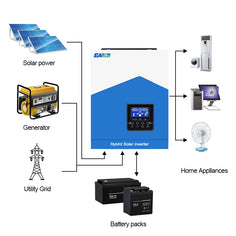Unlocking the Power of High-Efficiency Solar Inverters: Discover the Game-Changing Benefits and Innovations!
In the quest for sustainable energy solutions, solar energy has emerged as one of the most promising alternatives. At the heart of any solar energy system lies the solar inverter, a crucial component that converts the direct current (DC) produced by solar panels into alternating current (AC) suitable for home use or grid integration. Among the various types of solar inverters available, high-efficiency models, particularly the 3000w 24v solar inverter, stand out due to their superior performance and energy-saving capabilities. This article will explore the advantages of these high-efficiency solar inverters, their technical specifications, and the diverse applications they support, ultimately illuminating their role in promoting sustainability and energy independence.

Understanding High-Efficiency Solar Inverters
High-efficiency solar inverters are designed to maximize the conversion of solar energy into usable electrical power. These inverters play a pivotal role in any solar energy system, ensuring that the electricity generated from solar panels is effectively utilized. The efficiency of a solar inverter is typically measured by its conversion ratio, which indicates how much of the DC power is successfully converted into AC power. High-efficiency solar inverters boast ratings above 90%, meaning they waste less energy during the conversion process. Various factors contribute to this level of efficiency, including advanced circuitry, thermal management systems, and innovative design features that enhance performance even under less-than-ideal conditions. Understanding these elements is crucial for anyone considering solar energy solutions, as they directly influence the overall effectiveness and return on investment of solar installations.
Benefits of High-Efficiency Solar Inverters
The advantages of high-efficiency solar inverters extend far beyond mere energy savings. Firstly, these inverters can significantly boost the overall performance of a solar energy system, allowing households and businesses to generate more usable electricity from the same amount of solar panel output. This is particularly beneficial in areas with limited sunlight, where maximizing energy production is essential. Additionally, high-efficiency inverters often have longer lifespans compared to their lower-efficiency counterparts, reducing the need for replacements or maintenance over time. This durability translates into lower overall costs and less waste, aligning with environmental sustainability goals. Speaking to a friend who recently installed a high-efficiency solar inverter, they noted a remarkable decrease in their electricity bills, contributing to both financial savings and a reduced carbon footprint. Such experiences highlight the tangible benefits these systems can provide to users.
Technical Specifications of 3000w 24v Solar Inverters
Diving deeper into the technical aspects, the 3000w 24v solar inverter is engineered to deliver optimal performance under various conditions. Its input/output voltage ratings are designed to match the specifications of most residential solar panel setups, ensuring compatibility and efficiency. With an efficiency rating typically exceeding 95%, this model stands out in its ability to convert DC to AC with minimal energy loss. Moreover, the power factor of these inverters is usually close to 1, indicating that nearly all the energy produced is utilized effectively. When compared to lower-efficiency models, the 3000w 24v inverter showcases superior performance, enabling users to harness more energy from their solar systems. Understanding these specifications not only aids in selecting the right inverter but also emphasizes the importance of investing in technology that maximizes solar potential.
Applications of High-Efficiency Solar Inverters
The versatility of high-efficiency solar inverters makes them suitable for a wide array of applications across residential, commercial, and industrial sectors. In residential settings, homeowners can utilize these inverters to power their homes efficiently, significantly reducing reliance on grid electricity. For commercial enterprises, high-efficiency inverters can facilitate large-scale solar installations, powering everything from office buildings to manufacturing plants. Additionally, they are increasingly being integrated into renewable energy projects that aim to reduce greenhouse gas emissions. A friend of mine recently implemented a high-efficiency solar inverter in their small business, which allowed them to power their operations sustainably while cutting costs. Such practical applications underscore the growing importance of these inverters in our transition to renewable energy sources.
Key Insights on High-Efficiency Solar Inverters
In summary, high-efficiency solar inverters, particularly the 3000w 24v models, are game-changers in the realm of solar energy. Their ability to maximize energy conversion not only leads to significant cost savings but also supports a more sustainable future. As we continue to seek innovative solutions for energy needs, embracing these advanced technologies becomes increasingly important. The insights shared in this article highlight the critical role that high-efficiency solar inverters play in enhancing energy independence and reducing our carbon footprint. Whether you're a homeowner or a business owner, considering the integration of high-efficiency solar inverters could be a pivotal step towards a greener tomorrow.
 Series/TV Show
Series/TV Show 

